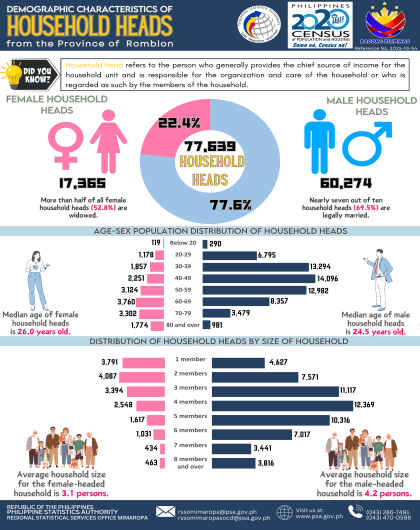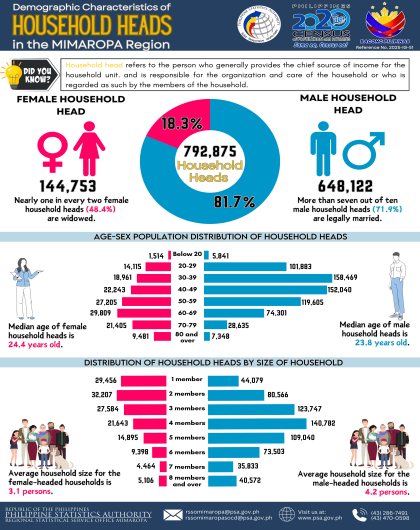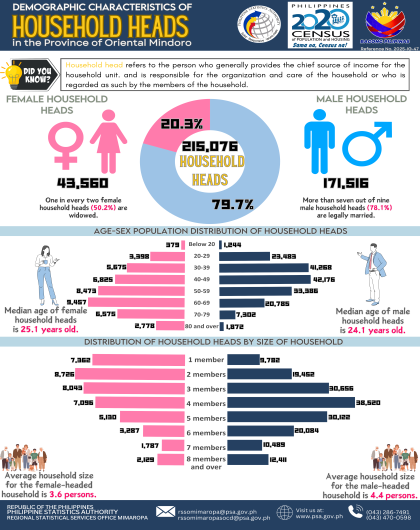Nearly one in every 75 persons 15 years old and over from Occidental Mindoro’s household population is an overseas worker
In 2020, about 4,554 persons, or 1.3 percent of the province of Occidental Mindoro’s household population 15 years old were overseas workers. Moreover, there was a decrease of 480 persons, or 9.5 percent, compared to the 5,034 overseas workers reported in the 2015 Census of Population (2015 PopCen). (Figure 1 and Table A)
An overseas worker is one who is currently out of the country due to overseas employment. He/she may or may not have a specific work contract or may be presently at home on vacation but has an existing overseas employment to return to.
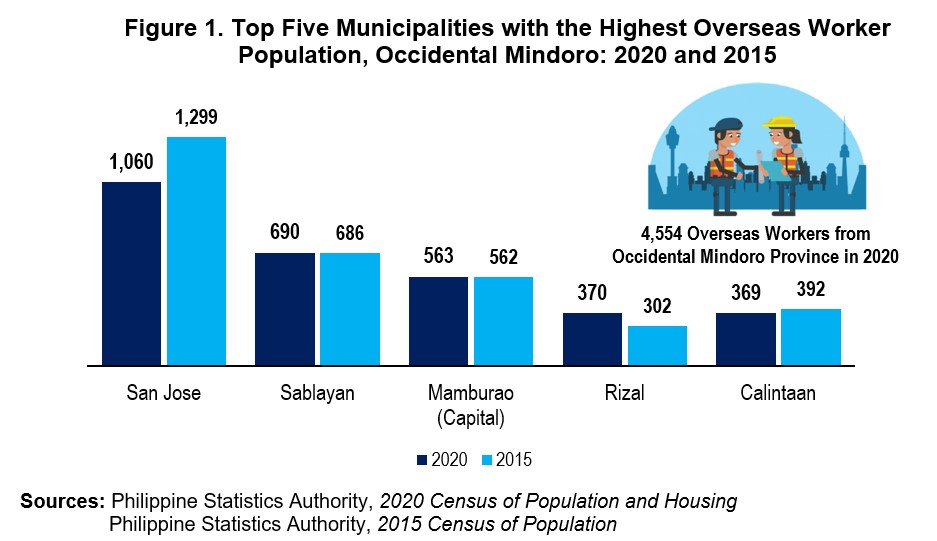
San Jose registered the biggest proportion of overseas workers
Among the municipalities in the province, San Jose had the highest number of overseas workers, with 1,060 persons. This constitutes 23.3 percent of the total overseas workers from the province of Occidental Mindoro. In addition, there were 239 persons or 18.4 percent, decreased compared to the 1,299 overseas workers from this municipality as reported in the 2015 PopCen. Meanwhile, the municipality with the lowest number of overseas workers was Looc, with just 95 persons. This corresponds to a 2.1 percent share of the provincial population of overseas workers.
Compared to the 2015 PopCen, the following municipalities experienced a decline in the reported number of overseas workers besides San Jose, namely Calintaan (5.9%), Abra de Ilog (14.3%), Lubang (51.3%), and Looc (60.1%). (Table A)

In 2020, overseas workers from Occidental Mindoro were most prevalent in Lubang, with a 2.2 percent share of the municipality’s household population, compared to other municipalities. Other municipalities with proportion of overseas workers greater than the provincial proportion of 1.3 percent include: Calintaan (1.9%), Mamburao (1.8%), Looc (1.7%), Paluan (1.6%), Rizal (1.4%), and Magsaysay (1.4%). Meanwhile, San Jose had the lowest percentage share of overseas workers, at 0.7 percent. (Figure 2 and Table A)
Sex ratio among overseas workers stands at 75 males per 100 females
Of the 4.6 thousand overseas workers from Occidental Mindoro, nearly 2.6 thousand (57.1%) were female, while about 2.0 thousand (42.9%) were male. This translates to a sex ratio of 75 males for every 100 females. (Table 1)
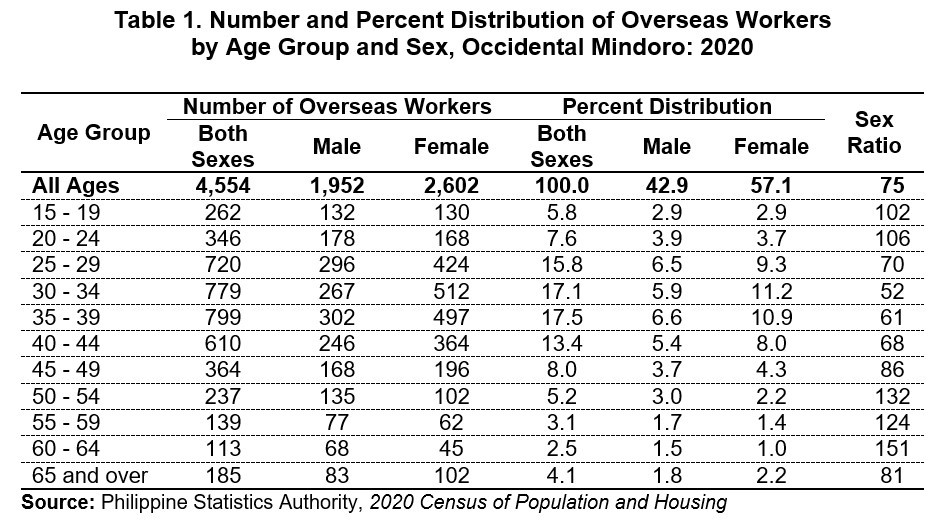
The highest representation of overseas workers in terms of age group is between 35 to 39 years, with a total of 799 persons, or 17.5 percent of the total number of overseas workers from the province. Other age groups with more than a 10.0 percent share of the provincial total include 30 to 34 years with 779 persons (17.1%), 25 to 29 years with 720 persons (15.8%), and 40 to 44 years with 13.4 percent. (Table 1)
Females outnumbered males among overseas workers aged 25 to 49 years and 65 years and older from Occidental Mindoro. Notably, the sex ratio for these age groups ranges from 52 to 86 males per 100 females. On the other hand, males dominated females in the age groups 15 to 24 years and 50 to 64 years, with a sex ratio ranging from 102 to 151 males per 100 females. (Table 1)
More than half of overseas workers are legally married
Of the 4.6 thousand overseas workers from Occidental Mindoro, around 2.3 thousand persons, or 51.3 percent, were legally married. In addition, 1.2 thousand persons, or 26.2 percent, were never married. The rest of the total population of overseas workers was categorized as follows: in a common-law or live-in marital arrangement (13.7%), divorced, separated, or annulled (5.0%), and widowed (3.8%). (Figure 2 and Table B)
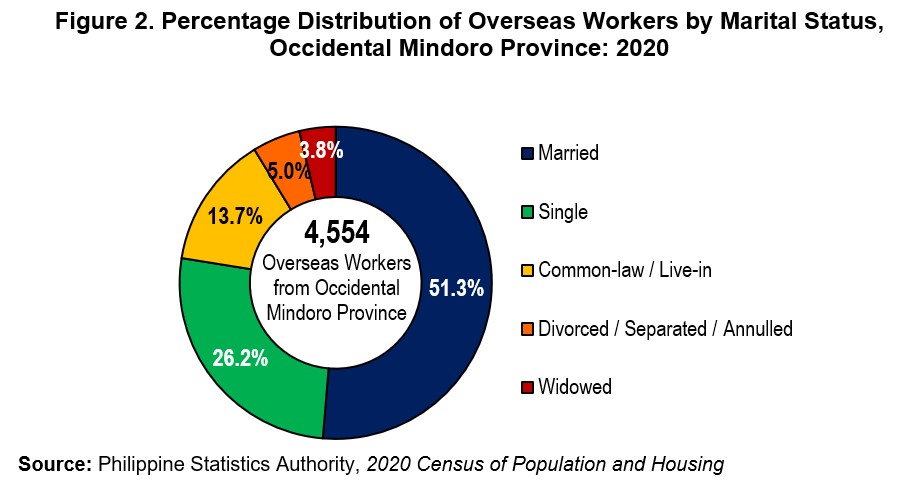
More than nine in every ten overseas workers are Non-Indigenous Peoples
Among the 4.6 thousand overseas workers, nearly 4.4 thousand, or 97.2 percent, were classified as non-Indigenous Peoples. Of these, Tagalog had the largest share at 63.4 percent, followed by Bisaya/Binisaya (15.5%), and Ilocano (14.8%). (Figure 3, Table C and Table D-1)
Moreover, 89 overseas workers from the province, or 2.0 percent, belonged to ethnic groups identified by the National Commission on Indigenous Peoples (NCIP) as Indigenous Peoples. Nearly three out of ten, or 29.2 percent, of these overseas workers were Mangyan-Iraya. Other major Indigenous Peoples groups where overseas workers originated include Mangyan-Alangan (13.5%), Mangyan-Hanunuo (11.2%), Mangyan-Ratagnon (6.7%), and Batangan (5.6%) and Bago (5.6%). (Figure 3 and Table D-2)
Nearly one in every 500 overseas workers have dual citizenship
In 2020, about 4,554 overseas workers from Occidental Mindoro were Filipino citizens. This comprised 99.4 percent of all overseas workers from the province. Females outnumbered males, with a sex ratio of 75 male overseas workers per 100 females. (Table 2 and Table E)
On the other hand, 12 overseas workers from the province held dual citizenship (0.3%), and 17 overseas workers were foreign citizens (0.4%). Males had an equal share with females among overseas workers with dual citizenship. However, among overseas workers with foreign citizenship, males dominated females with a 5.8 percent share. (Table 2 and Table E)
Among the overseas workers with dual citizenship from the province, Filipino-Americans had the highest percent share at 41.7 percent and was followed by Filipino-Italians at 25 percent and Filipino-Canadians at 16.7 percent. (Table F-1)
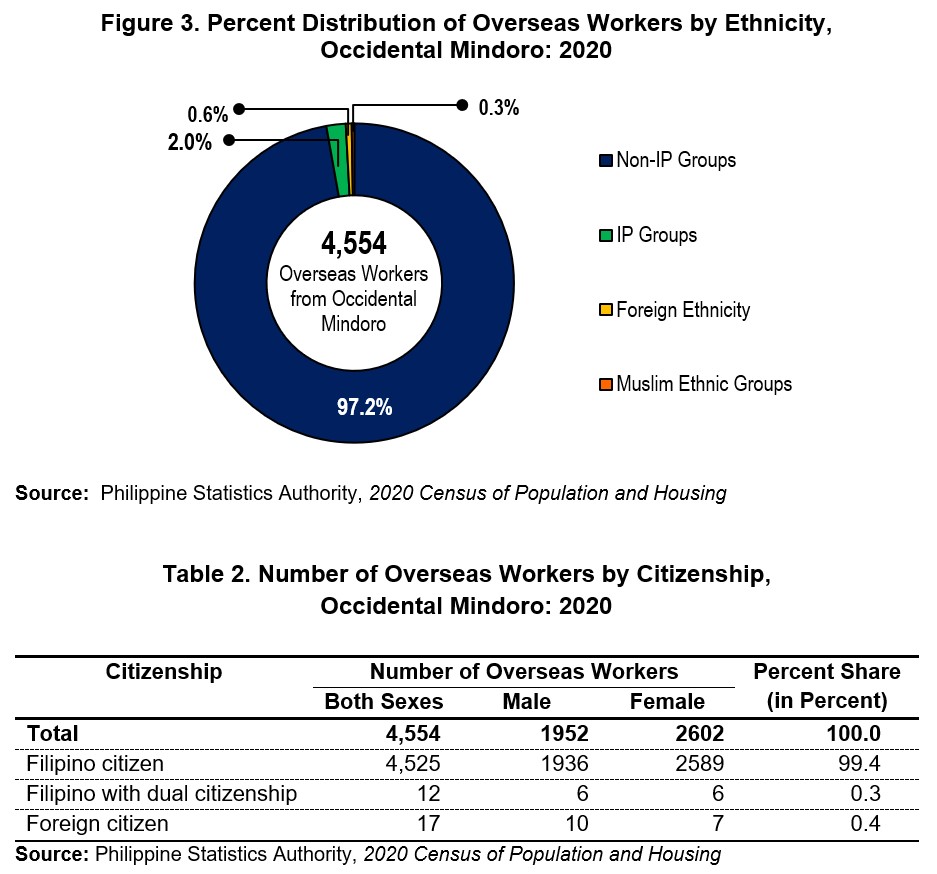
On the number of overseas workers from the province with foreign citizenship relative to the reference date and time of the census, those who were citizens of Japan had the highest share of 35.3 percent. This was followed by citizens of Germany, China, and Viet Nam each, with an 11.8 percent share. (Table F-2)
Four in every five overseas workers are Roman Catholic
Of the 4.5 thousand overseas workers from Occidental Mindoro, 79.0 percent, or 3.6 thousand persons, reported Roman Catholic as their religious affiliation. This was followed by Iglesia ni Cristo with 246 overseas workers (5.3%), Seventh-day Adventist with 96 overseas workers (2.1%), and the Church of the Foursquare Gospel in the Philippines Incorporated with 64 overseas workers (1.4%). (Table 3)
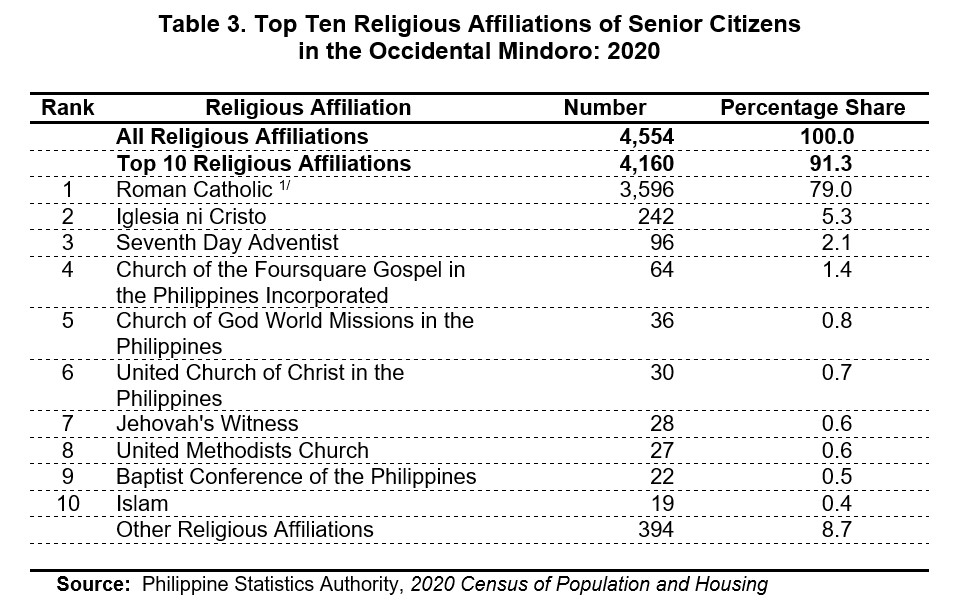
More than nine in every 20 overseas workers have reached college level
Among the 4.5 thousand overseas workers, nearly 2.1 thousand persons, or 45.1 percent, had reached or completed college level (graduate: 30.9%, and undergraduate: 14.2%). This was followed by overseas workers who reached or completed high school level, at 1.5 thousand or 34.6 percent (graduate: 21.9%, and undergraduate: 12.7%), and those with elementary level education, at 427 persons or 9.4 percent (graduate: 4.8%, and undergraduate: 4.6%). Furthermore, around 2.3 thousand overseas workers from the province, or 5.9 percent, attained or finished a short-cycle tertiary course (graduate: 5.7%, and undergraduate: 0.2%). (Figure 4 and Table G)
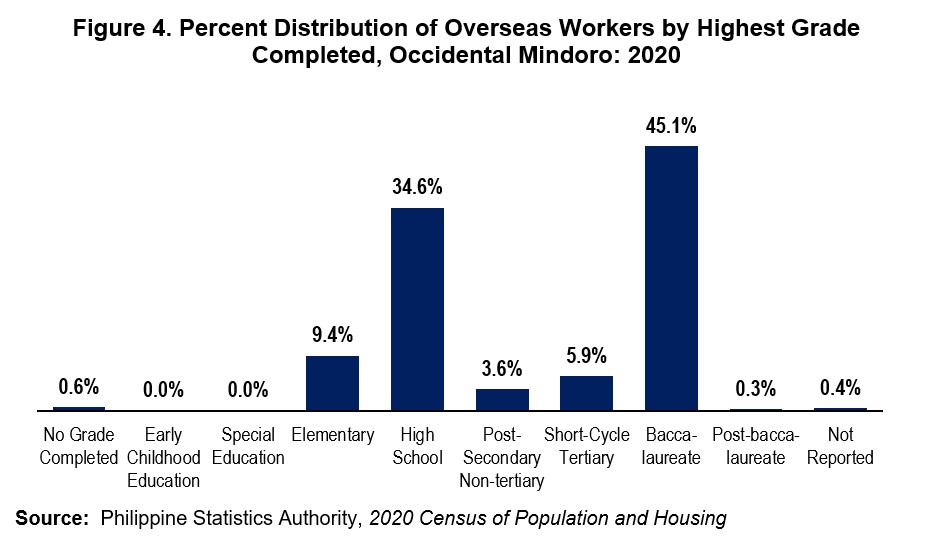
The statistics presented in this special release were based on the information provided by the respondent or any responsible member of the household who may provide accurate answers to the questions and give correct information about the household.
(SGD) LENI R. RIOFLORIDO
Regional Director
MLLM / OHG / RRL / CNB


